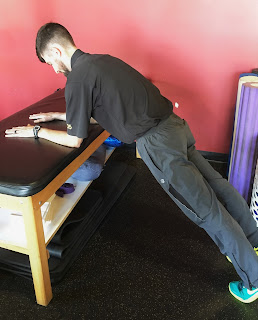Do you remember your first plank you
were asked to hold? Did it feel like the seconds were minutes and that someone
had lit a fire under muscles in your stomach that you never knew you had? Well
if you dread the plank or are having a difficult time maintaining good form
here are a couple methods to use to improve your experience.
Do you ever get pain in your lower back? Set up is key!
When preparing to plank it is important
to remember the focus of the exercise is preventing hyperextension of the lower
back. That being said, engaging the
muscles of the lower abdomen and pelvis properly before even lifting off of the
table is crucial in preventing any excessive motion in the lower spine. One
strategy is utilizing the Posterior Pelvic Tilt. This exercise will teach you
how to build tension in your lower abdomen and create a “flat back” to help aid
in any drooping or arching of the lower back when in the prone position.
Supine
Posterior Pelvic Tilt with Ball Squeeze
Begin by lying on your back with your knees bent and
feet flat on the floor. Place a ball between your knees and squeeze. Slowly
bend your low back and tilt your pelvis towards the floor. Return to start
position.
Do you feel more pressure in your shoulders than your stomach?
Improper alignment of the shoulders over
the elbows can cause abnormal strain on the individual’s tendons and ligaments
of the shoulder joint leading to possible injury. It is just as important to
ensure to keep the weight of your torso from sinking to the ground as well as
shifting forward during the plank. This can again place a shearing force across
the joint line of the shoulder and needs to be avoided. One exercise that can
help is the Scapular Push Up on a Table.
Plank on
Table with Scapular Protraction Retraction
Place both hands on the edge of a table and step your
feet back into a plank position. Slowly round your upper back, pulling your
shoulder blades apart. Next, lower your back down, squeezing your shoulder blades
apart.
Remember to breathe!
How often do we tend to hold our breath
when performing strenuous exercise? This sometimes can hurt you more than help
you. In our case with the plank, a deep exhale through pressed lips can help
tighten your core just before you lift up and continue to hold the ribs down to
prevent hyperextension at the back during the hold. Quadruped Diaphragmatic
Breathing drills can help you establish a good spinal position as well as core
contraction just from breathing!
Quadruped
Diaphragmatic Breathing
Begin on all fours. Breathe in, pushing your abdomen
down, then exhale and repeat. Make sure there is no movement in your chest or
shoulders as you breathe.
Plank Progressions:
Plank with Elbows on Table --> Plank on Knees --> Standard Plank
Plank with Elbows on Table
Plank on Knees
Standard Plank
Blog post by Craig Moody.








No comments:
Post a Comment